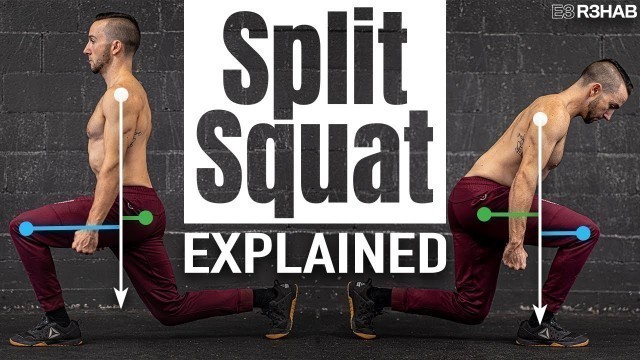'How To Perform The Split Squat (Form | Technique Tips)'
Posted Mar 13, 2022


'The split squat is a popular exercise used primarily for strength development of the lower legs. Unlike the basic squat pattern which focuses on bilateral strength, the split squat is used for the purpose of emphasizing unilateral leg strength. Like squats and lunges, split squats will place primary emphasis on the strength of the glutes, adductors, and quadriceps muscles, while also activating the hamstrings to a lesser degree. Depending on who you ask, the split squat can be executed a variety of ways. Some coaches may stand firm behind the notion that there is only one way to perform the movement (ie “front shin must always be vertical”), while others might be a bit more lenient on how it is performed. The reality is that there are a variety of ways to perform the split squat. The specific body position or technique one chooses is often based-off of individual needs. Some individuals will adjust the movement so it is more comfortable, while others may choose a variation based on performance goals. To manipulate the demands of the split squat, we can focus on three major areas: relative torso angle, relative shin angle, and foot placement. Changing one, or multiple of these variables can have a direct effect on joint range of motion, muscle activation, as well as provide insight on how to modify the movement in the presence of pain. Foot placement: A longer stride will most likely result in a vertical shin and a posterior weight shift (more weight on the back leg). In contrast, a shorter stride will most likely result in a forward angle shin (front foot) and an anterior weight shift (more weight on the front leg). By manipulating relative shin and torso position, we get four different options for executing the split squat: 1. Forward torso and forward shin 2. Forward torso and vertical shin 3. Vertical torso and vertical shin 4. Vertical torso and forward shin Looking at the principles of biomechanics, each of these options will have subtle differences in force vectors and moment arms thus changing the relative demand placed around the hip and knee joints. Which version is best? Well it depends. They are all great options, as the split squat is arguably one of the best exercises for building single leg strength. Stay tuned for future videos on the split squat covering considerations for performance, pain, and variations. Introduction - 0:00 Split Squat Overview - 0:29 4 Options - 2:04 Forward Torso and Forward Shin - 2:45 Forward Torso and Vertical Shin - 3:39 Vertical Torso and Vertical Shin - 4:20 Vertical Torso and Forward Shin - 4:58 ----- Programs: https://e3-rehab.myshopify.com/collections/programs Clothing: https://e3-rehab.myshopify.com/collections/frontpage Instagram: https://www.instagram.com/e3rehab/ Podcast: https://e3rehab.com/podcast/ Blog: https://e3rehab.com/blog/ MASS Research Review: http://bit.ly/E3MASS Affiliates: https://e3rehab.com/affiliates/ ----- Disclaimer: The information presented is not intended as medical advice or to be a substitute for medical counseling but intended for entertainment purposes only. If you are experiencing pain, please seek the appropriate healthcare professional. ----- Some of the links in this description are affiliate links which means that we\'ll earn a small commission if you click on the link and purchase a product. You are not required to use any of our links, but we do our best to put out as much free content as possible so we appreciate any support. ----- References Neumann, Donald. Kinesiology of the Musculoskeletal System: Foundations for Rehabilitation. Elsever. 2010.'
Tags: leg workout , leg exercises , hypertrophy , lower body exercises , split squat , muscle hypertrophy , MUSCLE ACTIVATION , split squat form , Bulgarian split squat form
See also: weightloss , squat workout , Tik , hip hop , weights , fitness journey , life , sin , gymlife , women s workout
comments- 'hot Fitness Girls Naughty'
- 'Frankie DiVita Voices The Pound Rockout Workout Infomercial'
- 'PONTE PA\' MI - Justin Quiles ❌ Anthony Ramirez | ZUMBA FITNESS Choreo Dance Baile Latino Guatemala'
- 'foods that can cause miscarriage'
- 'Leg Exercise How to Goblet squat'
- 'इन गलतियों के कारण मिसकैरेज होता है? | These mistakes Cause Miscarriage In Pregnancy | Hindi | Sehat'
- 'Customers\' Gym Tour'
- '#sabir_raftaar #karate #blackbelt #fighter #gym #workout #motivational #fitness'
- 'latex leather pretty outfits for women and girls #latex #fashion #leather #latest #outfitideas'
- 'pushups , calisthenics ,bodybuilding ,#yash anand,#yash Sharma fitness ,#sahilkhan#rubal dhankar'
- 'Plus Size Fashion Nova Model Costina Munteanu Lifestyle|Age|Bio| Curvy Model Costina Munteanu Outfit'
- 'Baile en CASA- 1 hora de Cardio Dance #21 - Non stop Zumba Fitness - Natalia Vanq'
- 'Outfits of the Week | Winter 2016 OOTW'
- 'I Finished Caroline Girvan\'s FUEL Program | most drastic results I\'ve ever seen omg'
- 'A WEEK OF OUTFITS | CASUAL WINTER OUTFIT IDEAS *MUM FRIENDLY* | FEBRUARY 2023'
- 'How To Do The Bird Dog | Cult Fit | Cure Fit #Shorts'
- 'Bonus Round Dip Station and Weights: Melissa Bender'